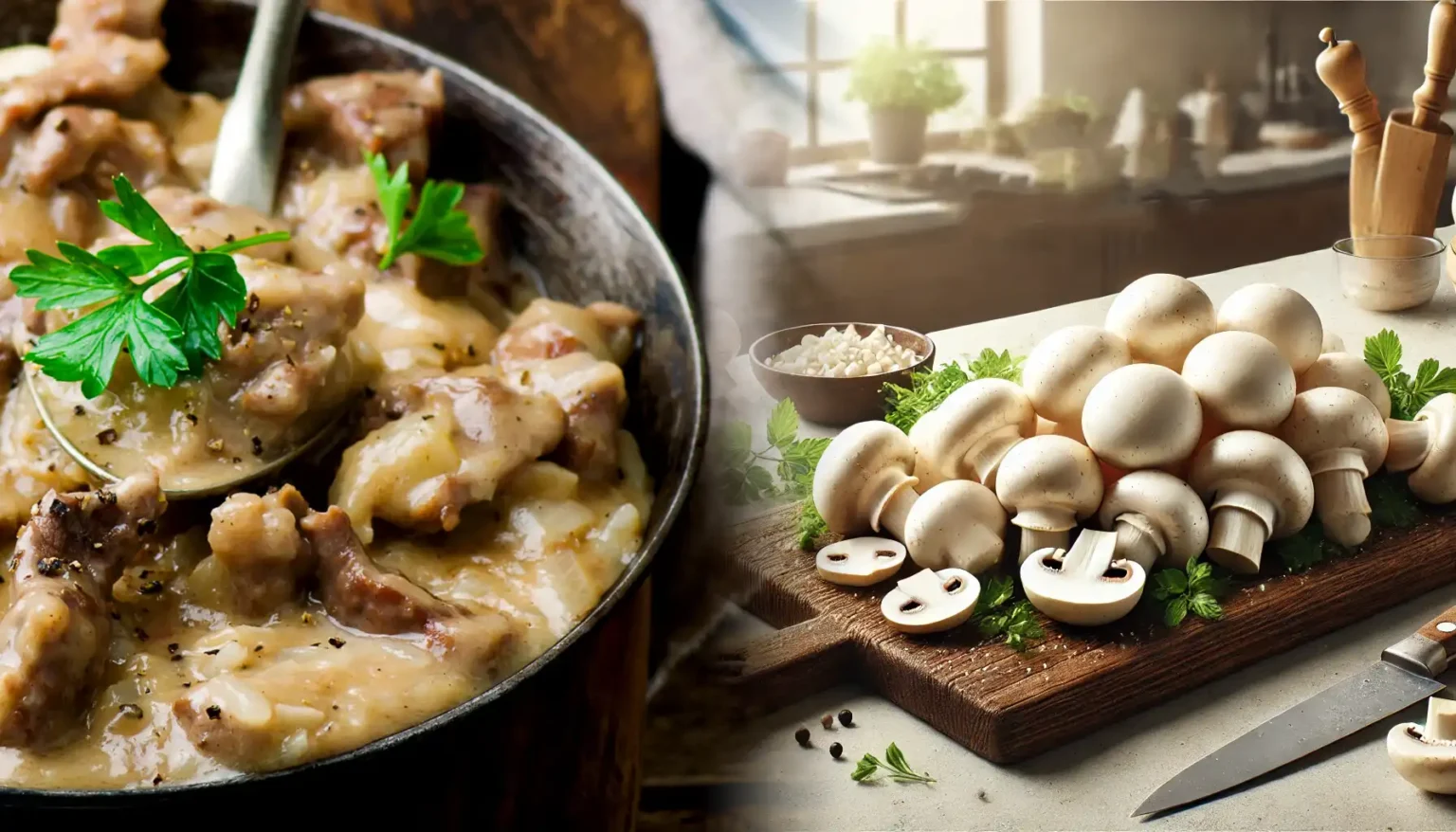Button mushrooms, one of the most popular varieties of edible mushrooms worldwide, are a true staple in kitchens across the globe. Known for their mild flavor and smooth, rounded caps, these mushrooms are as versatile as they are nutritious. From being the star ingredient in creamy soups to a tasty topping for pizzas, button mushrooms have earned their place in countless dishes.
But what makes button mushrooms so special? Beyond their culinary appeal, they are packed with essential nutrients, low in calories, and brimming with antioxidants, making them a “superfood” worth celebrating. Whether you’re a health enthusiast or simply love their earthy taste, button mushrooms are a perfect addition to your diet.
In this article, we’ll explore:
- What button mushrooms are and how they’re grown.
- Their incredible nutritional benefits and health perks.
- Easy, mouthwatering recipes to help you enjoy them to the fullest.
Let’s dive into everything you need to know about this versatile superfood and why it deserves a spot on your plate!
What Are Button Mushrooms?
Button mushrooms, scientifically known as Agaricus bisporus, are one of the most widely consumed and versatile types of mushrooms in the world. Recognizable by their smooth, white caps and firm texture, they are celebrated for their mild, earthy flavor that adapts effortlessly to various cuisines and dishes. Whether served raw in salads or cooked into hearty soups and sauces, button mushrooms are a staple ingredient for home cooks and professional chefs alike.
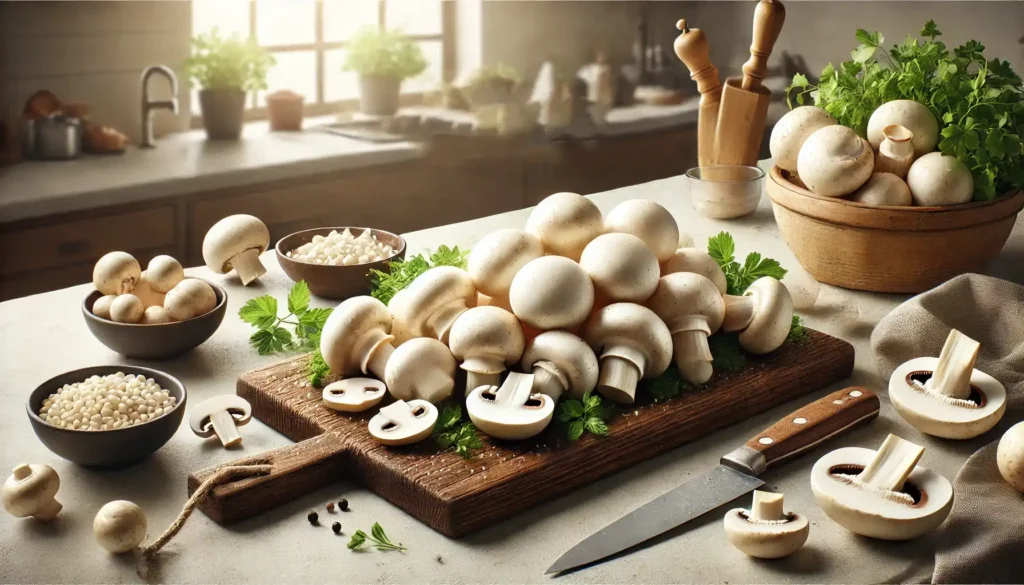
How Do Button Mushrooms Compare to Other Mushrooms?
Button mushrooms are part of the same species as cremini and portobello mushrooms, with differences arising from their stage of maturity:
- Button Mushrooms (Young Stage): These are the youngest form of Agaricus bisporus. They are white, tender, and mild in flavor, making them a popular choice for versatile cooking.
- Cremini Mushrooms (Middle Stage): Often referred to as “baby bellas,” cremini mushrooms are slightly older than button mushrooms. They have a firmer texture and a darker, earthier flavor.
- Portobello Mushrooms (Mature Stage): Fully mature Agaricus bisporus mushrooms are large, brown, and meaty. Their bold flavor and hearty texture make them ideal for grilling or using as a meat substitute.
These three mushrooms are essentially the same species, harvested at different points in their growth cycle, offering a range of flavors and textures to suit various dishes.
The History and Origin of Button Mushrooms
The cultivation of button mushrooms has a long and fascinating history:
- Ancient Roots: Mushrooms have been consumed for centuries, with ancient cultures appreciating their taste and nutritional value. However, the organized cultivation of button mushrooms began much later.
- France in the 17th Century: Button mushrooms were first cultivated in France during the 1600s. Parisian growers discovered how to farm mushrooms in dark, damp environments, leading to the nickname “champignon de Paris.”
- Modern Cultivation: Today, button mushrooms are grown globally in controlled environments to ensure year-round availability. They thrive in dark, cool conditions with composted soil, making them a sustainable and highly accessible food source.
Nutritional Value of Button Mushrooms
Button mushrooms (Agaricus bisporus) are not only a culinary favorite but also a nutritional powerhouse. These small, white mushrooms are packed with essential vitamins, minerals, and antioxidants, making them a valuable addition to a healthy diet. Let’s dive into their nutritional profile and explore the benefits they offer for overall wellness.
Calorie and Nutrient Profile
Button mushrooms are incredibly low in calories, making them an ideal choice for those looking to maintain or lose weight without compromising on nutrition. Here’s a breakdown of their key nutrients (per 100 grams, raw):
- Calories: 22 kcal
- Carbohydrates: 3.3 g
- Protein: 3.1 g
- Fat: 0.3 g
Key vitamins and minerals include:
- B-Complex Vitamins: Rich in riboflavin (B2), niacin (B3), and pantothenic acid (B5), which support energy production and brain health.
- Vitamin D: When exposed to sunlight, button mushrooms synthesize vitamin D, essential for bone health and immune function.
- Selenium: A powerful antioxidant that protects cells from damage and supports thyroid function.
- Potassium: Helps regulate blood pressure and supports heart and muscle function.
Benefits of Their Low-Calorie and High-Antioxidant Profile
- Weight Management
Button mushrooms are low in calories yet high in fiber and protein, making them a filling food that supports healthy weight management. - Antioxidant Properties
They contain antioxidants like ergothioneine and glutathione, which help neutralize free radicals, reducing oxidative stress and the risk of chronic diseases like cancer and heart disease. - Digestive Health
The fiber content in button mushrooms promotes healthy digestion and supports gut bacteria, improving overall gut health.
How Button Mushrooms Support Overall Wellness
- Immunity Boost
The combination of selenium and vitamin D in button mushrooms enhances the immune system, helping the body fight off infections and inflammation. - Heart Health
Potassium aids in maintaining healthy blood pressure, while the antioxidants reduce cholesterol buildup, promoting cardiovascular wellness. - Brain Function
B-complex vitamins, particularly niacin and riboflavin, support cognitive function, mood regulation, and the body’s ability to combat mental fatigue. - Bone Health
The vitamin D content in button mushrooms supports calcium absorption, which is vital for maintaining strong bones and preventing osteoporosis.
Health Benefits of Button Mushrooms
Button mushrooms (Agaricus bisporus) are more than just a versatile ingredient in the kitchen—they’re a nutritional powerhouse with numerous health benefits. Packed with antioxidants, fiber, and essential nutrients like vitamin D, button mushrooms offer a range of perks for your body and overall well-being.
Rich in Antioxidants: Supporting Immunity and Reducing Inflammation
Button mushrooms are an excellent source of antioxidants such as ergothioneine and selenium. These compounds play a vital role in protecting your cells from damage caused by free radicals, which are linked to aging and chronic diseases.
- Boosting Immunity: The antioxidants in button mushrooms strengthen the immune system, helping the body ward off infections and illnesses.
- Reducing Inflammation: Ergothioneine, in particular, has anti-inflammatory properties that can lower the risk of conditions like arthritis and cardiovascular disease.
Pro Tip: Incorporate button mushrooms into your meals during cold and flu season to give your immune system a natural boost.
High in Fiber: Promoting Gut Health and Aiding Digestion
Dietary fiber is essential for maintaining a healthy digestive system, and button mushrooms are a great source of this important nutrient.
- Gut Health: Fiber promotes the growth of beneficial gut bacteria, improving digestion and reducing issues like constipation.
- Digestive Regularity: Consuming fiber-rich foods like button mushrooms helps regulate bowel movements and supports overall digestive health.
Fun Fact: The fiber in button mushrooms is not only beneficial for digestion but also contributes to better nutrient absorption.
Source of Vitamin D: Benefits for Bone Health and Mood
Button mushrooms are unique among plant-based foods because they can produce vitamin D when exposed to sunlight or UV light. This makes them an excellent dietary source of this crucial nutrient, especially for those following vegetarian or vegan diets.
- Bone Health: Vitamin D enhances calcium absorption, supporting strong bones and reducing the risk of osteoporosis.
- Mood Regulation: Adequate levels of vitamin D are linked to improved mood and reduced symptoms of depression.
Pro Tip: Look for button mushrooms labeled “vitamin D-enhanced” at your grocery store to maximize these benefits.
Low in Calories: Perfect for Weight Management
For those looking to maintain or lose weight, button mushrooms are an ideal food choice. They are low in calories yet high in nutrients, making them satisfying without adding excess calories to your diet.
- Weight Loss: Substituting higher-calorie ingredients with button mushrooms in recipes can help reduce overall calorie intake.
- Feeling Full: The combination of fiber and protein in button mushrooms keeps you feeling satisfied longer, reducing the likelihood of overeating.
Fun Fact: A 100-gram serving of raw button mushrooms contains only 22 calories, making them a guilt-free addition to any meal.
Common Uses of Button Mushrooms
Button mushrooms (Agaricus bisporus) are celebrated worldwide for their versatility in the kitchen. Their mild flavor, firm texture, and ability to absorb seasonings make them an essential ingredient in various cuisines. Whether raw, cooked, or used as a meat substitute, button mushrooms are a culinary favorite that enhances the flavor and nutrition of countless dishes.
Popular Dishes Featuring Button Mushrooms in Various Cuisines
Button mushrooms shine in a wide variety of dishes across global cuisines:
- Italian Cuisine: Sliced button mushrooms are a classic addition to pasta sauces, risottos, and pizza toppings.
- Asian Cuisine: Stir-fries, ramen, and hot pot dishes often feature button mushrooms for their texture and ability to soak up flavorful broths and sauces.
- American Cuisine: They’re commonly found in creamy soups, casseroles, and grilled dishes like burgers or steaks.
- French Cuisine: Sautéed button mushrooms are a staple in dishes like coq au vin or as a topping for toast with garlic and herbs.
Using Button Mushrooms Raw, Cooked, or as a Meat Substitute
Button mushrooms are incredibly adaptable and can be enjoyed in a variety of ways:
- Raw:
- Add thinly sliced button mushrooms to salads for a crunchy, earthy twist.
- Use them as a topping for wraps or sandwiches to boost flavor and nutrition.
- Cooked:
- Sautéed: Sauté them in garlic and olive oil as a quick side dish.
- Soups and Stews: Their umami flavor intensifies when simmered in soups or stews.
- Stuffed: Fill them with breadcrumbs, cheese, or herbs for an elegant appetizer.
- As a Meat Substitute:
- Chop and cook them into sauces or tacos for a plant-based alternative to ground meat.
- Use them in veggie patties or lasagnas as a hearty, nutritious substitute for beef or chicken.
Why Button Mushrooms Are a Staple in Vegetarian and Vegan Diets
Button mushrooms are a favorite among vegetarians and vegans due to their:
- Umami Flavor: Their natural savoriness enhances plant-based dishes, making them more satisfying.
- Nutritional Value: They provide essential nutrients like protein, B vitamins, and selenium, which are often lacking in plant-based diets.
- Versatility: Button mushrooms can replicate the texture of meat in dishes like mushroom stroganoff, shepherd’s pie, or burgers.
Pro Tip: Pair button mushrooms with legumes or grains to create balanced, protein-rich vegan meals.
How to Buy, Store, and Prepare Button Mushrooms
To enjoy the full flavor and nutritional benefits of button mushrooms, it’s essential to buy them fresh, store them properly, and prepare them the right way. Here’s a comprehensive guide to help you make the most of this versatile superfood.
Tips for Selecting Fresh Mushrooms at the Store
When shopping for button mushrooms, look for these signs of freshness:
- Appearance: Choose mushrooms with firm, smooth, and white caps. Avoid any that are slimy, wrinkled, or discolored.
- Underside of the Cap: Check the gills under the cap. They should be tightly closed or just slightly open, indicating freshness.
- Feel: The mushrooms should feel dry but not dehydrated. Mushrooms that are overly moist may spoil quickly.
Pro Tip: Buy pre-packaged mushrooms only if the packaging is intact and has ventilation holes to prevent moisture buildup.
Proper Storage to Maintain Freshness
Fresh button mushrooms are best consumed within a few days of purchase, but proper storage can extend their shelf life:
- Refrigeration: Store mushrooms in the refrigerator in their original packaging or transfer them to a paper bag. Avoid plastic bags, as they trap moisture and accelerate spoilage.
- Keep Them Dry: Do not wash mushrooms before storing them. Moisture can cause them to become slimy or spoil faster.
- Avoid Crowding: Arrange mushrooms in a single layer or loosely packed to allow air circulation.
Shelf Life: When stored properly, fresh button mushrooms can last 4–7 days in the fridge.
Basic Preparation: Cleaning, Slicing, and Cooking Methods
Before cooking, ensure your button mushrooms are clean and ready to use:
- Cleaning:
- Gently wipe mushrooms with a damp paper towel or use a soft-bristle brush to remove dirt.
- If necessary, rinse quickly under cold water, but dry them immediately with a clean towel to avoid water absorption.
- Slicing and Preparing:
- Trim the ends of the stems if they appear dry or woody.
- Slice mushrooms evenly to ensure consistent cooking.
- Cooking Methods:
- Sautéing: Heat oil or butter in a skillet and cook sliced mushrooms over medium heat until golden brown, about 5–7 minutes. Add garlic or herbs for extra flavor.
- Grilling: Brush whole mushrooms with olive oil, season with salt and pepper, and grill for 4–5 minutes on each side.
- Roasting: Toss mushrooms with olive oil, garlic, and your favorite seasonings. Roast at 400°F (200°C) for 20–25 minutes until tender and caramelized.
Pro Tip: Avoid overcrowding mushrooms in the pan when sautéing or roasting. Overcrowding can cause them to steam instead of browning.
Delicious Recipes Featuring Button Mushrooms
Button mushrooms are incredibly versatile and lend themselves to a wide range of dishes. Whether you’re looking for a quick side dish or a hearty main course, these recipes showcase the delicious potential of button mushrooms. Let’s dive into five mouthwatering ways to enjoy this superfood!
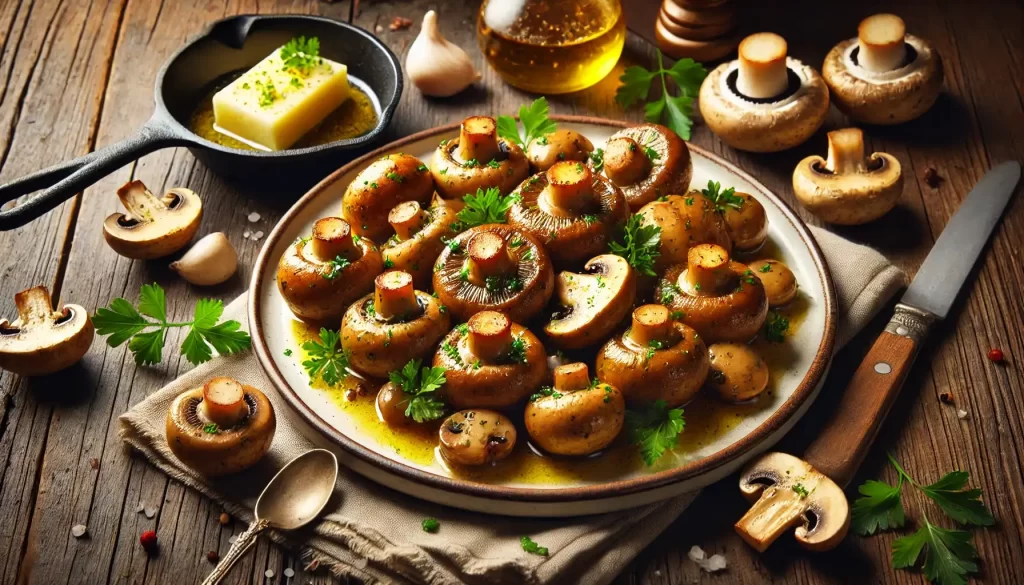
Recipe 1: Garlic Butter Sautéed Button Mushrooms (Quick and Easy Side Dish)
Ingredients:
- 2 cups button mushrooms, cleaned and halved
- 3 tbsp butter
- 3 cloves garlic, minced
- Salt and pepper to taste
- 1 tbsp chopped fresh parsley
Instructions:
- Heat butter in a skillet over medium heat.
- Add garlic and sauté until fragrant, about 1 minute.
- Add mushrooms and cook for 5–7 minutes until golden brown and tender.
- Season with salt and pepper, sprinkle with parsley, and serve warm.
Why You’ll Love It:
This simple side dish pairs perfectly with steak, chicken, or pasta.
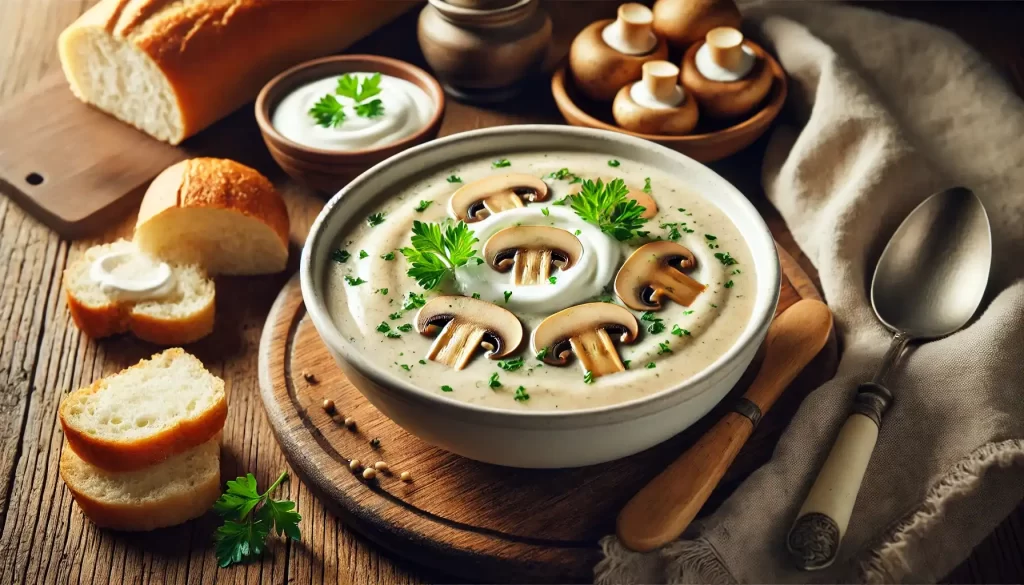
Recipe 2: Creamy Button Mushroom Soup (Rich and Comforting)
Ingredients:
- 4 cups button mushrooms, sliced
- 1 onion, chopped
- 3 cloves garlic, minced
- 3 tbsp butter
- 2 cups vegetable broth
- 1 cup heavy cream
- Salt and pepper to taste
Instructions:
- Melt butter in a pot and sauté onions, garlic, and mushrooms until soft.
- Add vegetable broth and simmer for 10 minutes.
- Blend the mixture until smooth, then return to the pot.
- Stir in heavy cream, season with salt and pepper, and heat through.
Why You’ll Love It:
Perfect for chilly days, this soup is creamy, hearty, and satisfying.
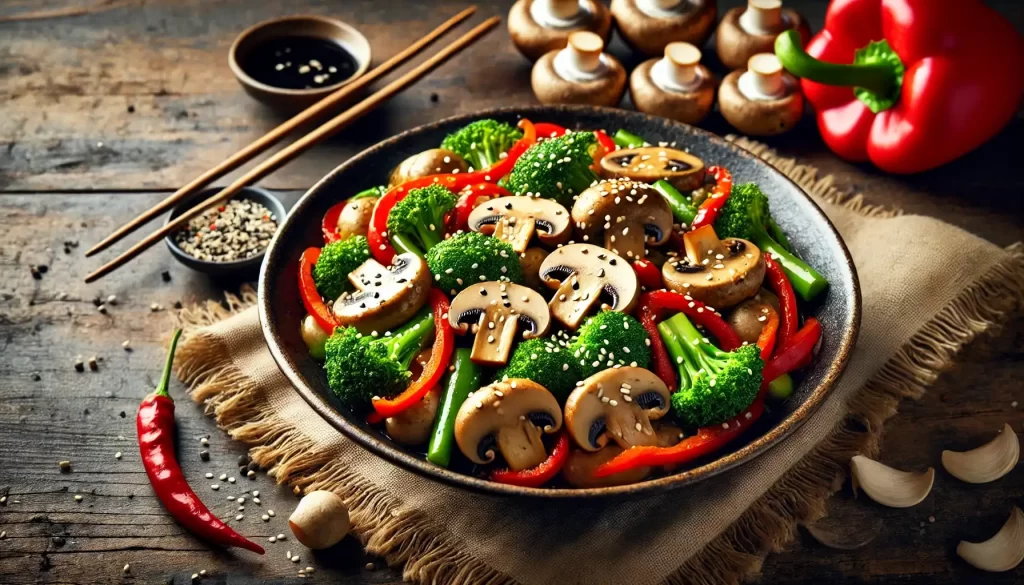
Recipe 3: Button Mushroom Stir-Fry (Asian-Inspired Recipe)
Ingredients:
- 2 cups button mushrooms, sliced
- 1 red bell pepper, sliced
- 1 cup broccoli florets
- 2 tbsp soy sauce
- 1 tbsp sesame oil
- 1 tbsp grated ginger
- 1 tbsp sesame seeds
Instructions:
- Heat sesame oil in a wok over high heat.
- Add ginger and sauté for 30 seconds.
- Toss in mushrooms, bell pepper, and broccoli, and stir-fry for 5–7 minutes.
- Drizzle with soy sauce, sprinkle with sesame seeds, and serve.
Why You’ll Love It:
This quick, healthy stir-fry is packed with flavor and perfect for weeknight dinners.

Recipe 4: Stuffed Button Mushrooms (Perfect Appetizer)
Ingredients:
- 12 large button mushrooms, stems removed
- 1 cup cream cheese, softened
- 1/4 cup grated Parmesan cheese
- 2 cloves garlic, minced
- 2 tbsp chopped fresh herbs (parsley or chives)
Instructions:
- Preheat oven to 375°F (190°C).
- Mix cream cheese, Parmesan, garlic, and herbs in a bowl.
- Fill each mushroom cap with the mixture.
- Place on a baking sheet and bake for 15–20 minutes, until golden and bubbly.
Why You’ll Love It:
A crowd-pleasing appetizer that’s both elegant and easy to make.
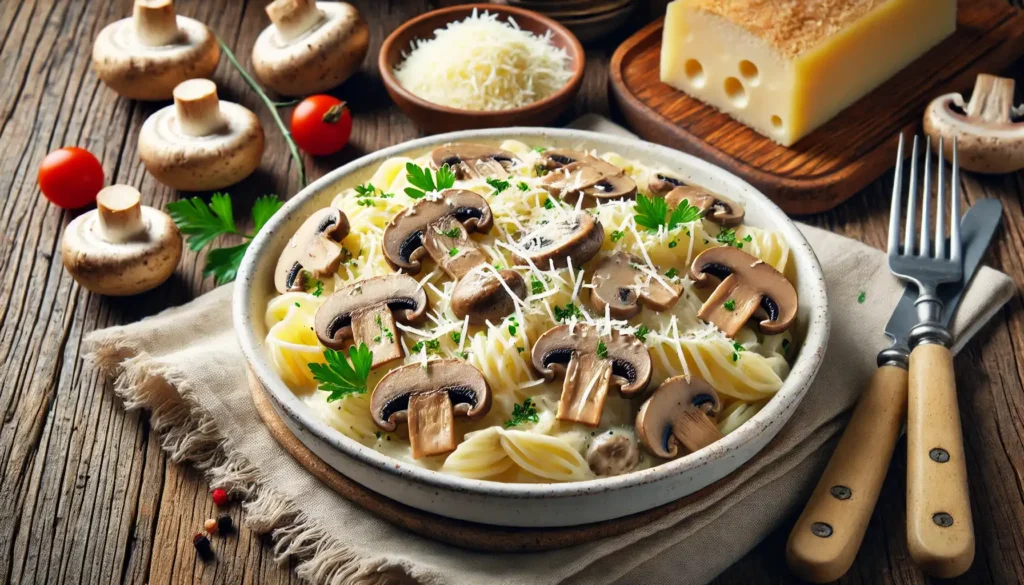
Recipe 5: Button Mushroom Pasta (A Hearty Main Course)
Ingredients:
- 300g pasta of your choice
- 3 cups button mushrooms, sliced
- 1 onion, chopped
- 2 tbsp olive oil
- 1 cup heavy cream
- 1/2 cup grated Parmesan cheese
- Salt, pepper, and fresh parsley to garnish
Instructions:
- Cook pasta according to package instructions; drain and set aside.
- Heat olive oil in a skillet, sauté onions and mushrooms until soft.
- Add cream and Parmesan cheese, stirring until the sauce thickens.
- Toss the cooked pasta with the sauce, season with salt and pepper, and garnish with parsley.
Why You’ll Love It:
Creamy, comforting, and loaded with mushroom goodness, this dish is perfect for family dinners.
Fun Facts About Button Mushrooms
Button mushrooms are more than just a culinary staple—they have fascinating traits and a rich history that make them a unique addition to the world of food and nutrition. Here are some fun and surprising facts about this versatile superfood.
1. Button Mushrooms Are One of the Most Widely Consumed Mushrooms Worldwide
Button mushrooms (Agaricus bisporus) hold the crown as one of the most popular mushrooms globally.
- Global Popularity: Their mild flavor, affordability, and versatility make them a favorite in kitchens from North America to Asia.
- Universal Ingredient: Button mushrooms are a key ingredient in countless dishes, from pizza toppings in Italy to hearty soups in France and stir-fries in China.
Fun Fact: Button mushrooms account for over 40% of all mushroom production worldwide!
2. Button Mushrooms Transform as They Mature
Button mushrooms are not just a standalone variety—they’re the youngest stage of a single species (Agaricus bisporus) that matures into other well-loved mushrooms:
- Cremini Mushrooms (Middle Stage): Slightly older than button mushrooms, cremini mushrooms have a firmer texture and a darker, earthier flavor.
- Portobello Mushrooms (Mature Stage): Fully grown button mushrooms develop into large, meaty portobello mushrooms with a robust flavor.
Fun Fact: The same species offers three distinct culinary experiences, making Agaricus bisporus a truly versatile mushroom.
3. Button Mushrooms Have a Unique Ability to Absorb Vitamin D
Button mushrooms are among the few plant-based foods capable of producing vitamin D when exposed to sunlight or UV light.
- How It Works: Just like human skin, button mushrooms synthesize vitamin D when exposed to UV rays, increasing their nutritional value.
- Enhanced Vitamin D Mushrooms: Some commercially grown button mushrooms are exposed to UV light to boost their vitamin D levels, making them an excellent dietary source for those with limited sun exposure.
Pro Tip: Leave store-bought mushrooms in direct sunlight for 30–60 minutes to naturally enhance their vitamin D content.
Growing Button Mushrooms at Home
If you’ve ever wanted to cultivate your own fresh button mushrooms, the good news is that they’re relatively easy to grow at home. With the right setup and a little patience, you can enjoy an abundant supply of these versatile superfoods. Here’s a beginner-friendly guide to get started.
Beginner-Friendly Steps for Cultivating Button Mushrooms
- Choose Your Growing Method: Decide whether you’ll grow mushrooms indoors or outdoors. Indoors offers more control over conditions, while outdoor cultivation mimics natural growth.
- Prepare the Substrate: Button mushrooms grow best in nutrient-rich compost. You can buy pre-made compost for mushrooms or create your own using manure and straw.
- Inoculate with Spores: Purchase high-quality button mushroom spores or spawn from a trusted supplier. Spread the spawn evenly over the compost.
- Maintain Optimal Conditions: Keep the environment dark, cool (55–65°F or 13–18°C), and humid. Cover the compost with a thin layer of moist soil to encourage growth.
- Water and Monitor: Lightly mist the soil to keep it damp but not soggy. Avoid overwatering, as too much moisture can cause contamination.
Equipment Needed
To grow button mushrooms, you’ll need:
- Compost or Growing Medium: Rich in organic matter for optimal growth.
- Mushroom Spores or Spawn: Easily available online or at gardening stores.
- A Dark, Cool Space: A basement, garage, or shaded outdoor area works well.
- Misting Bottle: For maintaining proper humidity levels.
- Growing Containers: Shallow trays or boxes to hold the compost and mushrooms.
How to Harvest and Enjoy Homegrown Button Mushrooms
- Harvesting: Mushrooms are ready to harvest when their caps fully open, and the gills underneath are exposed. Gently twist or cut them at the base to avoid damaging the compost.
- Regrowth: After harvesting, the compost can produce several more flushes of mushrooms if maintained properly.
- Enjoying Your Harvest: Use your fresh mushrooms in salads, soups, or sautés. They’ll have a richer flavor than store-bought varieties.
Pro Tip: Homegrown button mushrooms taste best when used fresh but can also be stored in the fridge for up to a week.
Conclusion
Button mushrooms are a true culinary and nutritional gem, offering endless versatility in the kitchen and a host of health benefits. From boosting immunity and supporting heart health to their role as a sustainable food source, these mushrooms deserve a spot in everyone’s diet.
Whether you’re enjoying them in a simple sauté, adding them to soups, or experimenting with recipes like stuffed mushrooms or mushroom pasta, button mushrooms elevate any dish with their mild, earthy flavor.
For those with a green thumb, growing button mushrooms at home is a rewarding way to enjoy fresh, organic produce while reducing your environmental impact.
Embrace the many possibilities of button mushrooms and discover why they’re one of the world’s most beloved superfoods. Your health, taste buds, and the planet will thank you!

